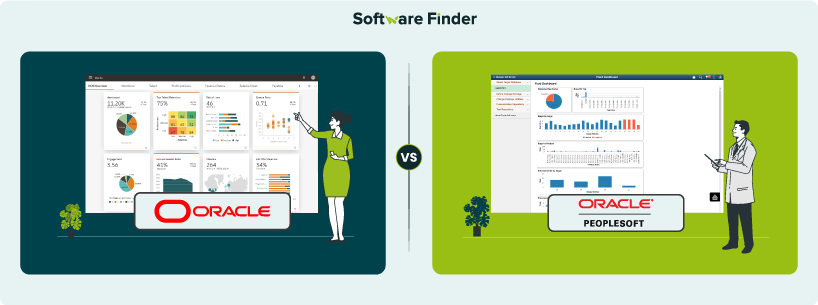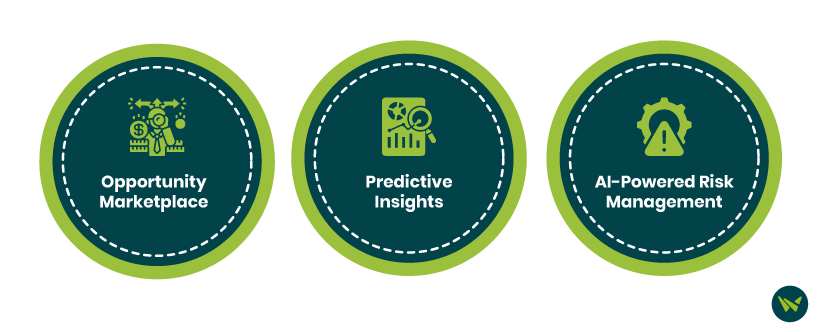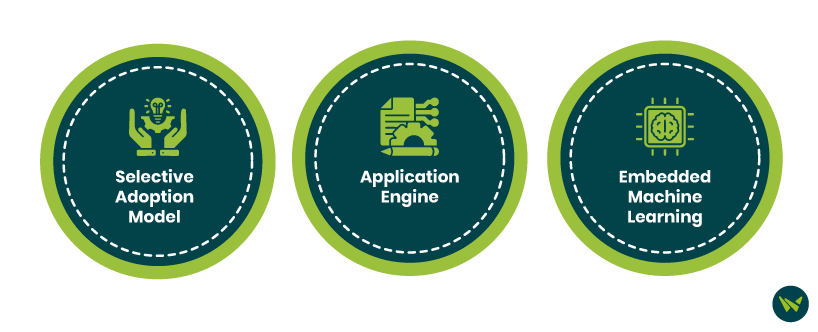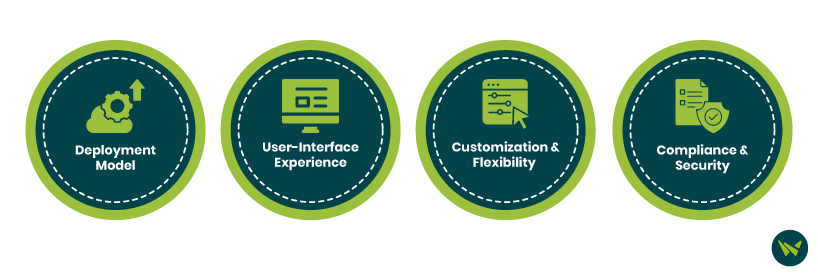
As organizations embrace digital transformation, human resource (HR) departments are leading innovation across industries. Oracle offers two major solutions in this space: Oracle Fusion Cloud ERP and PeopleSoft. Both are powerful enterprise-grade platforms used by organizations worldwide. PeopleSoft is a long-standing on-premises system that has been trusted for decades, while Oracle Cloud HCM is a modern, cloud-native solution designed for the future.
This Oracle Cloud vs PeopleSoft comparison explores their strengths and differences to help you decide which system aligns best with your business needs. Whether you are planning an upgrade or making a new investment, this comparison will support your decision-making process.
Feature | Oracle Cloud | PeopleSoft |
Deployment Model | Cloud-Based Platform | On-Premises Solution |
User Interface Experience | User-Centric Design | Traditional Enterprise UI |
Customization And Flexibility | Flexible Configuration Tools | Deep Customization Capabilities |
Compliance And Security | Automated Compliance Updates | Customizable Security Protocols |
Oracle Cloud HCM is a comprehensive, cloud-based human capital management (HCM) suite designed for modern enterprises. It brings together core HR processes, including recruiting, onboarding, performance management, and payroll, into a single, AI-powered platform. By centralizing these functions, it streamlines workflows, minimizes manual effort, and delivers real-time insights, enabling HR teams to make faster, data-driven decisions while enhancing the overall employee experience.
Standout Features

- Opportunity Marketplace: Oracle Cloud includes an integrated opportunity marketplace that acts as a one-stop shop for career development. It combines internal job postings, volunteering opportunities, and short-term gigs in a single platform, empowering employees to grow their skills, explore new roles, and contribute to cross-functional projects
- Predictive Insights: The software uses advanced predictive analytics to support smarter workforce planning. It helps HR leaders identify employees at risk of leaving, understand the impact of organizational changes on team performance, and quickly model workforce scenarios using prebuilt attributes. This enables proactive decision-making and more agile talent management
- AI-Powered Risk Management: An AI-powered system enhances compliance and security by detecting fraud and errors. It identifies anomalies such as ghost employees or unexpected payroll changes and enables deep segregation of duties (SoD) analysis, ensuring clear visibility into roles and privileges to meet regulatory standards
Pros And Cons
Pros:
- Personalized planning tools support predictive planning, forecasting, and financial operations with product-centric customization
- Custom forms and reports make it simple to build and tailor forms and documents to meet specific business needs
- Easily scales with growing or global businesses, supporting multiple currencies and compliance requirements with minimal effort
Cons:
- Occasionally, the layout can become inefficient, leading to awkward use of screen space, especially noticeable during system updates or changes
- Limited integration with other third-party software
PeopleSoft is an on-premises HCM solution widely used by large organizations. With over 30 years of proven success, it offers robust HR features such as workforce administration, payroll, talent management, and benefits administration. In addition to HR, it supports financial management and supply chain operations. Known for deep customizability, it enables businesses to tailor workflows and meet compliance requirements.
Standout Features

- Selective Adoption Model: This feature allows organizations to choose which updates and new features to implement and when rather than being forced to accept all changes at once. This flexibility helps businesses maintain critical customizations while still benefiting from ongoing innovation, with updates typically available every 10 weeks
- Application Engine: PeopleSoft offers high-volume data processing capabilities through its ‘Application Engine,’ enabling users to develop, test, and execute batch or online programs efficiently. It also features robust business process management (BPM) tools that support the creation of complex workflows and automation of business processes
- Embedded Machine Learning: Predictive analytics and intelligent, machine learning–driven recommendations are built into key modules like human capital management (HCM) and supply chain management (SCM). These capabilities make the platform especially valuable for midsize to large organizations looking to make smarter, data-driven decisions
Pros And Cons
Pros:
- Offers centralized tools to manage finances, track inventory, evaluate suppliers, and handle various business functions under one system
- Features a simple and intuitive interface, making it accessible for users at all levels to search, retrieve, and manage employee records efficiently
- The platform supports the development of custom reports and queries, with options to export data into various formats for broader usability
Cons:
- The system can feel clunky and occasionally slow when processing commands, especially due to the large volume of information it handles
- While customization is available, it may not be flexible enough to fully align with specific local country rules and regulations


Oracle Cloud follows a subscription-based pricing model, starting at $625/user/month, with a minimum requirement of 10 users. This makes it a higher upfront investment, best suited for mid-sized to large organizations looking for a scalable, cloud-based solution.
PeopleSoft offers more flexible payment options, including monthly or annual subscriptions, with pricing starting at $200/user/month. This makes it a more cost-effective choice upfront, especially for organizations that already maintain on-premises infrastructure.
Disclaimer: The pricing has been sourced from third-party websites and is subject to change.
Oracle Cloud HCM is ideal for organizations seeking a modern, cloud-native solution that delivers scalability, real-time insights, and simplified compliance. Its mobile-friendly interface and low-code configuration tools make it well-suited for fast-growing or globally distributed teams with evolving HR needs.
On the other hand, PeopleSoft remains a strong contender for businesses that require deep customization and full control over their infrastructure. Its flexibility supports unique workflows and compliance needs, particularly in industries with strict data residency or operational requirements.
Ultimately, the better choice depends on your organization’s priorities—whether it is cloud convenience and innovation with Oracle Cloud or customization and control with PeopleSoft. Consider your long-term digital strategy before making a decision.
